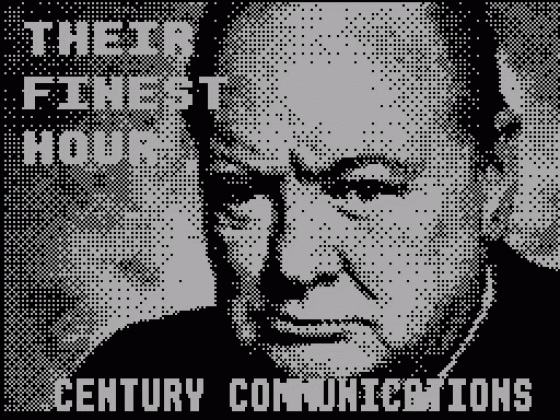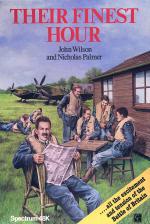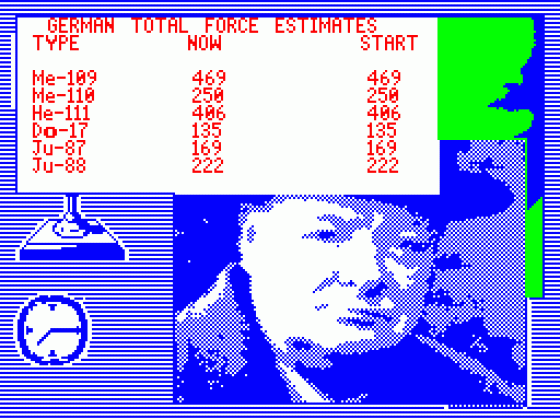
Crash
 1st March 1986
1st March 1986
Categories: Review: Software
Author: Derek Brewster
Publisher: Century
Machine: Spectrum 48K
Published in Crash #26
Their Finest Hour
Their Finest Hour is an icon driven strategy game out of the same mould as Century's previous release, The Fourth Protocol. That game was based upon the best seller by Frederick Forsyth and this game has an equally auspicious background as it finds its setting amongst the brave World War II pilots who inflicted Germany's first defeat of the war in the Battle of Britain.
Game design was by Nicholas Palmer, author of 'The Comprehensive Guide to Wargaming', and he has brought his love and knowledge of the genre to the computer screen with true military precision. The game is eminently playable and as your interest in the heroic exploits of these flying aces increases so you find yourself becoming more and more absorbed with the task of halting and eventually turning back the northward advance of- the Luftwaffe over southern England.
This game scores on all fronts: design; looks and playability. Design is centred around two map scales one a small-scale map showing southern Britain where dots represent radar stations, air bases and nine ports, and the other providing large-scale maps showing much smaller areas (eg Devon & Cornwall) where dots inside squares are air bases from which you launch your aircraft, anchors are ports, and five dice-like dots are the radar stations which scan the skies for the approaching German air force. Around the edge of the map screen are the main icons such as anti-aircraft flak, plane allocation to the ten air bases, and repairs to installations at the inning of each day.

You can alarm bases and direct planes during the day which leads you off into sub-menus where relative strengths can be increased or decreased. For example, the Alarm Sub-Menu gives the choice of putting the crews of an air base on hut, cockpit or plane alert where each represents an escalation in readiness for the approach of Goering's forces from the south. The computer knows which air base you wish to alter by an ingeniously simple method. A cursor glides over the map screens and you place it over the air base, radar station or port you are interested in. You can then use the icons around the sides to alter flak cover (which starts at two anti-aircraft guns per site), plane allocation to bases, or alert status for bases, or you can just request information via the information icon. This last feature is a very useful one as in such an involved game constant updates on information on both your own movements and those of the enemy forces are vital. Reports on enemy aircraft are not just plonked into your lap; a strong thread of strategy runs throughout the game and in this case the accuracy of reports on enemy movements is governed by weather conditions and the watchfulness of the radar crews and ground observers.
This is certainly a good-looking game. The maps are geographically accurate representations of southern Britain while the icons for such diverse operations as tape, keyboard/joystick, plane allocation and repairs are pleasing to the eye and reveal delightful detail. The icons are driven by whining a cute pointing hand around the edge of the maps with the SPACE key and selecting with ENTER. Sub-menus and bulletins are flashed up onto the screen in a very neat fashion in keeping with the looks of the game as a whole.
Not only is the game playable, it also has that rich blend of strategy which will ensure it is played long and often. Right From the start you can choose how fast time passes by selecting the clock icon and selecting a pulse rate between 1 (impossibly fast) and 255 (where every move can be scrutinised to the last). 30 is thought an expert's speed and 150 time enough for the anxious.
The attacking German forces are made up of ME109's, the main German fighters, ME110's the fighter bombers, and the HE 111's, JU 88's, DO 17's (Flying Pencils), and the JU 87's (Stukas) which are the (progressively lighter and faster) bombers but the heavy HE 111's and JU 88's do the most damage. The numbers of these aircraft types will vary each time you play and so you will look afresh each time at the initial Intelligence Assessment with its superb picture of Winston Churchill (his picture on the loading screen must be the best I've seen on a Spectrum). The battle begins on August 12 and can continue until September 21 when the British forces win if you haven't already been defeated. After each day's play Churchill calls you from his bunker to inform you how the War Cabinet assesses your progress. If your losses are severe Churchill asks for your resignation.
There are many strands of strategy running throughout the game. Well rested pilots are more then a match for the Luftwaffe, so early interceptions of the enemy forces should be on the highest rating of aggression lie 6 from the choice 0- 6). An aggression factor of 0 on your part sees your pilots intimidated by combat and they return to base. If the pilots are tired, and its worth noting that when in the air they tire very quickly, it is probably better to avoid combat unless the enemy force is composed more of heavy bombers than swift fighter craft.
After lunch each day your pilots will be tired and you should recall the most exhausted to base. Squadrons at the end of their tether should normally be rotated to Scotland, especially if the weather forecast is bad, making enemy raids less effective. You may decide not to alert some squadrons in the morning so as to keep them fresh for afternoon interceptions. Care must be taken to ensure German raids do not catch RAF planes on the ground. Squadrons on cockpit or runway alert can get themselves into the air quickly, but unalerted or hutalert bases run the risk of being caught hopping. However, the higher the alert the more tired the pilots will become so it is not such a good idea to go on too high alert too early.
The Luftwaffe goes mainly for radar installations and airfields at first, trying to crack your defences before they attack the ports and soften them up for invasion. Because of this it may well be a good idea to harden up defences (via the flak icon) along the southern coast radar stations, as it is these which give you the earliest detection of the advancing forces. Needless to say, should all your south coast radar stations become damaged, you are almost blind to the advancing forces, save the occasional ground observation. Your best planes are the Spitfires; they are slightly faster and more effective than the Hurricanes.
As with all complex games this one has its fare share of bugs. At one point in a game I had more planes destroyed during combat than actually existed and this resulted in having P762 planes left. Also, on destroying an entire German force, I was then constantly attacked by zero planes. The way the game stops whenever a message is up on the screen is, to me, a negative point as it gives valuable thinking time during which the players can collect their thoughts and coolly work out the best strategy. This is a luxury not afforded the strategists during World War II. Perhaps the combat algorithm is just that bit askew. During battle you can have the situation where one Hurricane (slower than the Spitfire) holds at bay a considerable German fighter force. The rate at which the pilots tire is a great cause for concern. During just one morning pilots become tired and can actually reach the end of their tether. All the while the advancing German pilots seem to keep remarkably fresh and just keep on coming at you!
Nicholas Palmer wanted to devise a game which gives the player the claustrophobic feel of crouching in a command centre struggling with insufficient material. He has constructed the game so that the computer controlling the German forces, far from being a passive opponent, exploits weaknesses in your defences intelligently. The strategy element varies from game to game, from day to day, and from one battle to the next. The one day option is very useful as the main option takes a long time to play. Because the strategy element is so pervasive the game becomes really absorbing and can hold your interest for a considerable period of time the one game can last days or even weeks. I think Their Finest Hour is a superb strategy game and a worthy successor to the popular Fourth Protocol.
Comments
Difficulty: choice of pace
Graphics: excellent
Presentation: excellent
Input facility: icon-driven
Response: fast
Other Reviews Of Their Finest Hour For The Spectrum 48K
Their Finest Hour (Century Communications)
A review by Max Phillips (Your Sinclair)
Their Finest Hour: The Battle Of Britain (Lucasfilm/US Gold)
A review by John Gilbert (Sinclair User)
Their Finest Hour: The Battle Of Britain (Lucasfilm/US Gold)
A review
Their Finest Hour (Century)
A review












